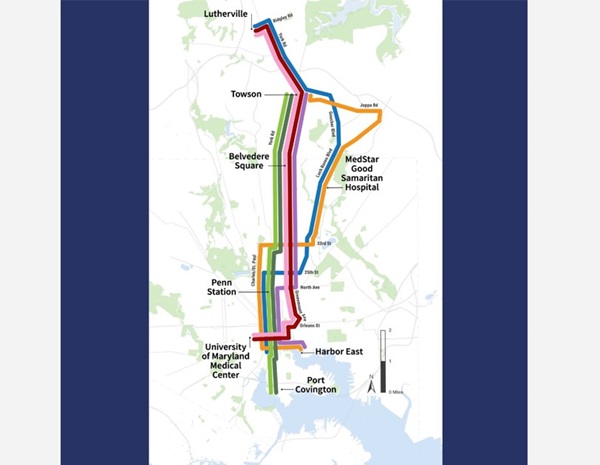BALTIMORE, MD—The Maryland Transit Administration has completed the feasibility study for the North-South Transit Corridor, designed to provide more mass transit connections between the Towson area of Baltimore County and downtown Baltimore.
The study, which will advance to analyze various options in the coming year, is part of the Central Maryland Regional Transit Plan, a 25-year plan released in October 2020 by a team that included the Regional Transit Plan Commission, the Baltimore Metropolitan Council, the public, and representatives from local jurisdictions.
“Public input is key to the success of transit initiatives,” said Maryland Transit Administrator Holly Arnold. “The response and interest our riders have shown in a more substantive north-south transit presence confirms that we’re on the right track. Our next steps will help us refine the proposed alternatives and gather additional public feedback.”
The North-South feasibility study explored a range of alignment and mode options – bus rapid transit, light rail and subway – intended to enhance service to the community by increasing mobility, access to jobs and connectivity to other transportation options in the corridor. Details on the study and the preliminary alternatives are available at https://rtpcorridors.com/northsouth.
Following presentation in fall 2022 of the preliminary alternatives in print, online and in-person, the study team conducted public engagement and gathered feedback to refine project goals, identify measures of effectiveness and enable data-based comparisons between the preliminary alternatives. From seven preliminary alternatives presented, the study concluded the following:
- A segment along York Road north of Towson as well as segments along Loch Raven Boulevard/Joppa Road/Goucher Boulevard – which were part of other Regional Transit Plan preliminary alternatives – will not be included in the next phase of study for this project.
- Further analysis is needed south of downtown Baltimore. The study indicated strong demand at both Harbor East and Baltimore Peninsula, and analysis of potential performance and input from stakeholders is needed to determine how to best serve those locations.
- Further analysis also will be needed to compare Greenmount Avenue with Charles and St. Paul streets to determine the best route between 33rd Street and North Avenue. Greenmount Avenue did not perform as well as Charles and St. Paul streets in this area, with the study finding lower projected ridership. However, employment densities to the west of the corridor and the distribution of transit-oriented population east of Greenmount Avenue warrant further analysis.
- Bus rapid transit, light rail and subway all will advance as options for further study and alternatives development.
In the alternative analysis phase starting in 2024, the project team will assess transit, traffic operations and environmental impacts of each alternative as well as combinations of different types of transit modes and connections to key destinations. The review also will evaluate potential access to federal funding.
Throughout the analysis phase, public engagement will be conducted to share progress and solicit input from the community. The next round of public engagement activities is planned for mid-2024.
Do you value local journalism? Support NottinghamMD.com today.

